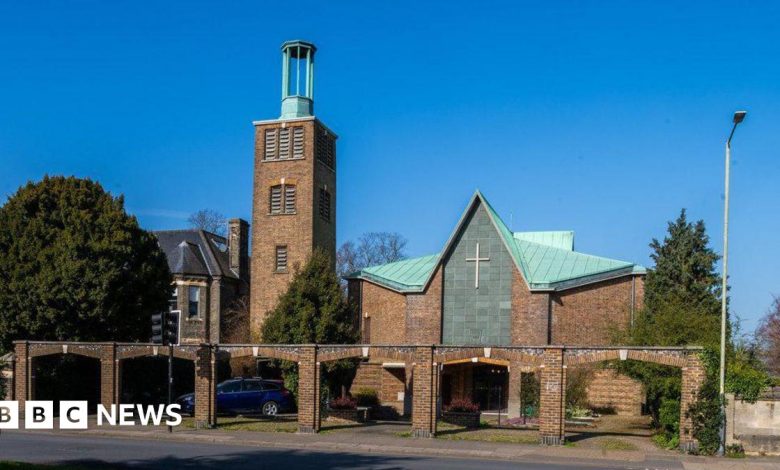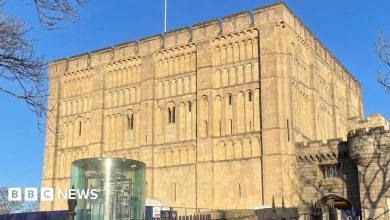Former URC church in Norwich on the market for £600K

The city’s landscape has undergone significant transformations over the years, with old buildings making way for new ones. One such example is the Grade II listed building that stands tall today, but its history dates back to the site of a disused Baptist chapel that was demolished in 1954. The story of this building is one of hope, resilience, and community, as it was rebuilt and dedicated two years later to become the home of the Trinity Presbyterian Church. This congregation has been an integral part of the city’s fabric since 1867, with its members gathering to worship, share, and support each other through thick and thin. The church’s journey, however, has not been without its challenges, as its original Theatre Street church was destroyed during the devastating years of World War Two, leaving the community to pick up the pieces and rebuild.
As the years went by, the Trinity Presbyterian Church continued to thrive, and in 1972, it became part of the United Reformed Church (URC). This union brought new life and energy to the congregation, and the church remained a vital part of the community. The building itself has undergone little change since its reconstruction, with the only notable addition being a lift installed at the back of the building to improve accessibility. This thoughtful addition reflects the church’s commitment to inclusivity and its desire to welcome people of all ages and abilities. Despite the many ups and downs, the church remained a constant presence in the city, a testament to the power of faith and community. However, as the years went by, the congregation began to feel the effects of changing times, and the retirement of its last minister, Rev John Potter, marked a significant turning point in the church’s history.
The decision to close the church last year was not taken lightly, and it is a testament to the challenges faced by many religious communities in today’s world. As the congregation said their final goodbyes, the future of the building hung in the balance. The uncertainty surrounding its future is a concern not just for the community but also for the city as a whole. The building, with its rich history and cultural significance, is more than just a physical structure; it is a symbol of the city’s heritage and a reminder of the values that have shaped its people. As Rev Coaker, of the URC, noted, the building’s ownership has reverted to the URC Eastern Synod Trust, which, in accordance with charity law, must sell the building at a professionally valued price. This development has sparked a mix of emotions, from sadness to hope, as the community waits with bated breath to see what the future holds for this beloved building.
As the city looks to the future, it is essential to remember the history and significance of this Grade II listed building. The Trinity Presbyterian Church has been a part of the city’s fabric for over a century, and its story is intertwined with that of the community. The building has witnessed countless moments of joy, sorrow, and celebration, and its walls have heard the prayers, songs, and stories of generations of worshippers. As the community navigates this uncertain time, it is crucial to acknowledge the building’s cultural and historical significance. The city’s residents, whether they are people of faith or not, have a stake in the building’s future, and it is essential to find a solution that respects its heritage while also embracing its potential for new life and purpose.
The retirement of Rev John Potter marked the end of an era for the Trinity Presbyterian Church, and the community is still coming to terms with the loss of its spiritual leader. Rev Potter’s dedication and service to the congregation have left an indelible mark on the community, and his legacy will continue to inspire and guide those who follow in his footsteps. As the church’s story comes full circle, it is essential to honor the memories and experiences of those who have worshipped within its walls. The building’s future may be uncertain, but its past is a testament to the power of faith, community, and resilience. As the city looks to the future, it must also acknowledge the debt it owes to the generations of worshippers who have made this building a sacred space.
As the URC Eastern Synod Trust considers the building’s future, it is essential to involve the community in the decision-making process. The city’s residents have a deep affection for this building, and their voices must be heard as the Trust explores options for its future use. Whether the building is sold, repurposed, or reimagined, it is crucial to ensure that its cultural and historical significance are respected and preserved. The Trinity Presbyterian Church may have closed its doors, but its story is far from over. As the city embarks on a new chapter in the building’s history, it is essential to remember the values of community, inclusivity, and compassion that have defined this sacred space for generations. The future of the Grade II listed building may be uncertain, but its past is a reminder of the transformative power of faith, hope, and community, and its legacy will continue to inspire and guide the city for years to come.









I am not rattling wonderful with English but I find this rattling easygoing to translate.
Thankyou for helping out, superb information.
Hello.This post was really motivating, particularly because I was browsing for thoughts on this topic last week.
I have been surfing on-line greater than three hours as of late, yet I never discovered any interesting article like yours. It’s lovely price enough for me. Personally, if all webmasters and bloggers made good content as you did, the web shall be much more useful than ever before.
Glad to be one of several visitors on this awing internet site : D.
In the grand design of things you’ll get an A for effort. Where exactly you actually confused me ended up being in all the particulars. As people say, the devil is in the details… And that could not be much more correct here. Having said that, allow me tell you exactly what did work. Your writing is incredibly engaging which is probably the reason why I am taking the effort in order to comment. I do not really make it a regular habit of doing that. Next, although I can easily see the jumps in logic you make, I am not really convinced of just how you seem to connect your details which in turn make your final result. For right now I will, no doubt yield to your point however hope in the future you connect your facts better.
I have recently started a website, the info you provide on this website has helped me greatly. Thanks for all of your time & work. “A physicist is an atom’s way of knowing about atoms.” by George Wald.
I am not sure where you’re getting your info, but great topic. I needs to spend some time learning much more or understanding more. Thanks for excellent information I was looking for this info for my mission.